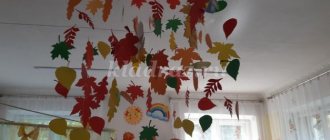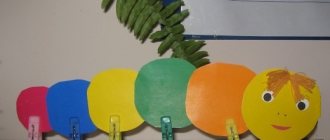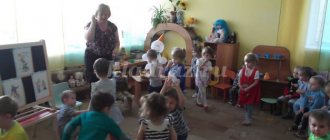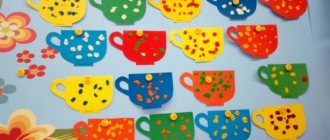Outline of a lesson in the first junior group on the educational activity “Artistic creativity. Modeling"
LESSON PLAN IN THE FIRST JUNIOR GROUP
ACCORDING TO THE NOD “ARTISTIC CREATIVITY. MOLDING"
TOPIC: “Strawberry meadow”.
Integration of educational areas: Socialization, Communication, Cognition, Work, Reading fiction.
Goals: to introduce children to the content of the fairy tale “Strawberry” by N. Pavlova; continue to teach to distinguish animals; develop memory; consolidate the ability to roll plasticine between the palms and other early acquired skills; distinguish the red color, admire the finished product.
Materials and equipment: flannelgraph, figures for flannelgraph (strawberry, snake, mosquito, bird, frog, mouse, cloud, sun), dummy strawberry, plasticine, napkin, board.
PROGRESS OF THE CLASS:
Organizational part.
Children with a teacher go to the window and watch the changes in nature
Educator: Every day it’s getting warmer and warmer outside. Trees, flowers, grass woke up. Look how green the grass has turned on our site. And there are already a lot of leaves on the trees. A little more - and the berries will begin to ripen in the forests, and the children’s favorite berry is the strawberry. But not only children like strawberries. Listen to a fairy tale about those who love strawberries just like you.
Main part.
Children sit on chairs in a circle, the teacher reads N. Pavlova’s fairy tale “Strawberry”.
“Shine the sun. A strawberry berry has ripened in the clearing. A mosquito saw it and squeaked: “The berry is ripe: red, fragrant!” The bird heard the mosquito and flew into the clearing. Wants to eat strawberries. The mouse heard the mosquito and ran into the clearing. Wants to eat strawberries. The frog heard the mosquito and jumped into the clearing. Wants to eat strawberries. The snake heard a mosquito and crawled into the clearing. Wants to eat strawberries. A cloud came over the sun. A mosquito saw her and squeaked: “It will rain, wet and cold!” The bird heard a mosquito and ran to the tree. The mouse heard a mosquito and quickly went into its hole. The frog heard a mosquito - quickly under the leaf. I heard a mosquito snake - hurry to the root. And the strawberry bathes in the rain and is glad that no one touched it.”
The teacher asks questions to the children and accompanies the children's answers by attaching figures to the flannelgraph.
- What was the weather like? (figurine of the sun) Which berry is ripe in the clearing? (strawberry figurine) What color is the berry? Who was the first to see the strawberry? (mosquito figurine) Who heard the mosquito? (alternately figures of a bird, a mouse, a frog and a snake) What did all the animals want to do? What happened next? How has the weather changed? (cloud figure) Where did the animals hide? Was the strawberry scared of the rain?
Physical education minute
The teacher invites the children to play the game “Who can find the strawberry?” He draws attention to the dummy strawberry and offers to fly to it like a mosquito and a bird, run like a mouse, jump like a frog, crawl like a snake. At the same time, children pronounce onomatopoeic words: “Z-z-z-z”, “Pi-pi-pi”, “Kva-kva-kva”, “Sh-sh-sh-sh”.
Modeling strawberries.
Educator. Look, guys, how many animals there are, but there is only one strawberry. Do you want all the animals to try the strawberries? (children's answers.) Then let's make a lot of berries for them. What color is a strawberry? (children's answers). Therefore, what color plasticine should we take? (children show and name the color.) That's right, we will sculpt strawberries from red plasticine. Look, the strawberry has the shape of a ball with a slightly elongated tip. Let's remember how we roll a ball. (Children perform circular movements with their palms.)
Then the teacher shows techniques for rolling plasticine balls and molding them into products.
-This is the kind of strawberry I grew up with. Are your strawberries growing?
During the modeling process, the teacher controls the methods of their work and helps children who have difficulty completing the task.
Reflection.
Children's work is laid out on a board.
Educator. What did we make today? (answers.) How many strawberries are there in our clearing? (answers.) For whom did we make so many strawberries? (answers.) Let's treat all the animals to berries! (Children offer toys to try strawberries)
Well, that's all guys, it's time for the animals to go to the forest, and you and I for a walk!
Get text



